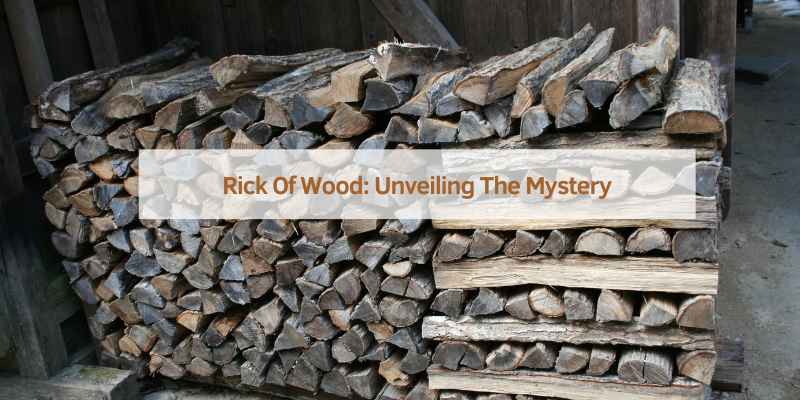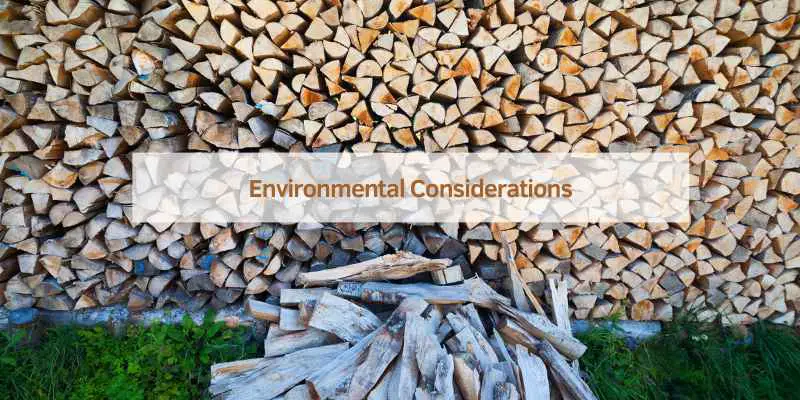A rick of wood is a unit of measurement used to quantify a stack of firewood. It typically refers to a pile of wood that measures 4 feet high, 8 feet long, and 4 feet wide.
When it comes to buying firewood, understanding the measurement of a rick of wood is essential. A rick is a standardized unit used by firewood suppliers to determine the quantity of wood being sold. It is typically a stack of firewood that is 4 feet high, 8 feet long, and 4 feet wide.
This measurement allows customers to easily estimate the amount of wood they need for their heating or cooking needs. Whether you are using a wood-burning stove, fireplace, or outdoor fire pit, knowing the size of a rick of wood can help ensure you have an adequate supply to keep you warm and cozy throughout the season.
Rick Of Wood: Unveiling The Mystery
Origins And Terminology
A rick of wood, often referred to as a “rick” or “cord,” has been a fundamental unit of measure in the timber industry for centuries. The term “rick” originates from the Old English word “hrīc,” meaning a stack or pile, which accurately depicts the nature of this measurement.
Measurements And Standards
The standard measurement for a rick of wood is typically 4 feet high, 8 feet long, and the width varies based on the length of the logs used. However, regional variations may exist, and it’s essential to adhere to local standards to ensure accuracy and consistency in the timber industry.

Types Of Wood In A Rick
When it comes to storing firewood, a rick is a popular choice for neatly stacking and organizing logs. The type of wood used in a rick can have a significant impact on its burning properties, longevity, and overall quality. Understanding the different types of wood commonly found in a rick can help you make informed decisions about your firewood supply.
Hardwood Vs. Softwood
Hardwood and softwood are the two main categories of wood found in a rick. Hardwood comes from deciduous trees like oak, maple, and birch. It tends to burn longer and produce more heat, making it ideal for sustained fires. On the other hand, softwood comes from coniferous trees such as pine, cedar, and spruce. While it ignites more easily, it burns faster and is better suited for kindling and quick heat.
Seasonal Variations
Seasonal variations in the wood found in a rick can impact its moisture content, which is crucial for efficient burning. During the warmer months, freshly cut wood with higher moisture levels is often stacked in the rick. As the wood seasons and dries, it becomes more suitable for use as firewood. Opting for seasoned wood can enhance the performance of your fireplace or wood-burning stove.
How To Measure A Rick Of Wood
A rick of wood is a pile of firewood that is measured in cords or fractions of a cord. It is important to know the exact measurements of a rick of wood to ensure that you are getting the right amount of firewood for your needs. In this guide, we will show you how to measure a rick of wood in a few simple steps.
Tools Needed
Before you start measuring your rick of wood, you will need a few tools:
- Tape measure
- Calculator
Step-by-step Guide
Follow these steps to measure your rick of wood:
- Measure the length of your rick of wood. Start at one end of the pile and measure to the other end. Make sure to measure the entire length of the pile, including any overhang.
- Measure the height of your rick of wood. Start at the ground and measure up to the highest point of the pile.
- Measure the depth of your rick of wood. Start at the front of the pile and measure to the back.
- Calculate the volume of your rick of wood. To do this, multiply the length, height, and depth measurements together. Then, divide the total by 128 to get the volume in cords. For example, if your rick of wood measures 8 feet long, 4 feet high, and 2 feet deep, the volume would be 64 cubic feet. Dividing by 128 would give you 0.5 cords.
It is important to note that a rick of wood can vary in size depending on the type of wood and how tightly it is stacked. This method will give you a rough estimate of the amount of firewood you have, but it is always a good idea to order a little extra just in case.
Storing Your Rick Of Wood
When it comes to storing your rick of wood, proper care is essential to maintain its quality and durability. Follow these tips to ensure your wood remains in optimal condition for use.
Ideal Locations
- Choose a well-ventilated area away from direct sunlight.
- Keep the wood elevated off the ground on pallets or blocks.
- Ensure the storage area is dry to prevent moisture damage.
Preventing Decay And Pests
- Inspect wood regularly for signs of decay or pest infestations.
- Apply a wood preservative treatment to prevent rot and insect damage.
- Seal any cracks or openings in the storage area to deter pests.
Uses Of A Rick Of Wood
Heating Your Home
Burning wood in a fireplace or wood stove provides efficient heat.
Outdoor Activities
Gather around a firepit for cozy gatherings or cookouts.
Buying And Selling Ricks Of Wood
A rick of wood is a unit of measurement for firewood. It typically consists of a stack of split wood that measures 4 feet high, 8 feet long, and the width of the individual logs. Buying and selling ricks of wood is a common practice for those who use wood as a primary source of heat or for outdoor activities such as camping and bonfires.
Are you looking to buy or sell ricks of wood? If so, you’ve come to the right place. In this post, we’ll cover everything you need to know about buying and selling ricks of wood, including finding suppliers and pricing factors.
Finding Suppliers
Finding suppliers for ricks of wood can be challenging, but there are a few ways to make the process easier. One way is to search online for local suppliers in your area. You can also check with your local hardware or home improvement store to see if they carry ricks of wood or can recommend a supplier.
Another option is to attend local farmers’ markets or craft fairs. Many vendors at these events sell ricks of wood, and you may be able to find a supplier who can meet your needs.
Pricing Factors
When it comes to pricing ricks of wood, there are several factors to consider. These include:
- Wood type
- Size of the rick
- Seasoned or unseasoned wood
- Delivery fees
The type of wood you choose will impact the price, with some varieties being more expensive than others. The size of the rick will also affect the price, with larger ricks typically costing more.
Seasoned wood is more expensive than unseasoned wood because it has been dried, which makes it burn more efficiently. Finally, delivery fees can add to the cost of the wood, especially if you are buying from a supplier who is located far away.
In Conclusion
Buying and selling ricks of wood can be a great way to heat your home or make some extra cash. By following the tips outlined in this post, you’ll be able to find a supplier and determine the best price for your needs. Whether you’re a buyer or a seller, ricks of wood can be a valuable commodity.
Safety Tips For Handling Wood
When working with wood, it’s important to prioritize safety to prevent accidents and injuries. By following proper handling techniques and using protective gear, you can ensure a safer woodworking experience. Below are some essential safety tips to keep in mind:
Proper Lifting Techniques
When lifting heavy pieces of wood, it’s crucial to use the correct techniques to avoid straining your back or causing muscle injuries. Follow these guidelines for safe lifting:
- Stand close to the object with your feet shoulder-width apart.
- Bend at the knees and keep your back straight.
- Grip the wood firmly and lift with your leg muscles.
- Avoid twisting your body while carrying the wood; instead, pivot your feet to change direction.
- If the wood is too heavy or bulky, ask for assistance or use mechanical aids like dollies or forklifts.
Protective Gear
Wearing appropriate protective gear is vital to shield yourself from potential hazards associated with woodworking. Consider the following protective equipment:
- Safety glasses or goggles: Protect your eyes from flying debris, wood chips, or dust.
- Ear protection: Use earplugs or earmuffs to minimize the risk of hearing damage caused by loud machinery or tools.
- Dust mask or respirator: Prevent inhaling harmful dust particles by wearing a mask or respirator, especially when sanding or cutting wood.
- Gloves: Wear gloves to protect your hands from splinters, sharp edges, or chemical irritants.
- Protective clothing: Consider wearing long sleeves, pants, and closed-toe shoes to safeguard against cuts, abrasions, or falling objects.
By following these safety tips and being mindful of potential risks, you can ensure a safer woodworking experience. Remember, prioritizing safety is essential for both professionals and hobbyists alike.
Environmental Considerations
Wood poses a risk of deforestation and habitat loss, impacting biodiversity. Unsustainable logging practices can lead to soil erosion and climate change, emphasizing the importance of responsible wood sourcing for environmental conservation.
Sustainable Harvesting
Sustainable harvesting is a key factor to consider when it comes to the environmental impact of wood. It involves the responsible and ethical management of forests to ensure the long-term availability of wood resources without depleting the natural ecosystem. By implementing sustainable harvesting practices, we can minimize the negative effects on the environment and promote the regeneration of forests for future generations.
Impact On Local Ecosystems
The extraction of wood can have various impacts on local ecosystems. It is important to be mindful of the potential disruption to wildlife habitats, soil erosion, and water quality. Clearcutting, for example, involves the removal of all trees in an area, which can result in the loss of biodiversity and disrupt the balance of the ecosystem. However, selective logging, where only specific trees are harvested, can have less severe impacts by preserving the integrity of the surrounding environment.
It is also crucial to consider the transportation of wood from the forest to the processing facilities. Heavy machinery and vehicles used in logging operations can cause damage to the soil structure and contribute to air pollution. However, with proper planning and adherence to sustainable practices, these negative impacts can be minimized.
In addition to the direct impact on ecosystems, the wood industry also plays a role in carbon sequestration. Trees absorb carbon dioxide from the atmosphere, helping to mitigate climate change. When wood is harvested sustainably, new trees can be planted in its place, continuing the cycle of carbon absorption and storage.
By understanding the environmental considerations associated with wood, we can make informed choices that support the preservation of our natural resources and ecosystems. Sustainable harvesting practices and responsible management are key to minimizing the negative impact on the environment and ensuring a sustainable future for the wood industry.

Frequently Asked Questions
What Are The Risks Of Wood Rot?
Wood rot poses a threat to the structural integrity of buildings. It can lead to decay, weakening of wooden structures, and potential safety hazards. Regular inspections and maintenance can help prevent wood rot.
How Does Wood Rot Occur?
Wood rot is caused by fungi that thrive in moist environments. When wood is consistently exposed to moisture, fungi break down its cellulose and hemicellulose components, leading to decay and structural damage over time.
Why Is It Important To Address Wood Rot Promptly?
Addressing wood rot promptly is crucial to prevent further damage and costly repairs. Ignoring wood rot can lead to structural instability, compromise the safety of the building, and require extensive renovations to rectify the issue.
Conclusion
Understanding the risk of wood rot is crucial for maintaining the integrity of wooden structures. By recognizing the causes and signs of wood rot, you can take proactive measures to prevent and address this issue. Regular inspections and timely repairs can help safeguard your property from the damaging effects of wood rot.


